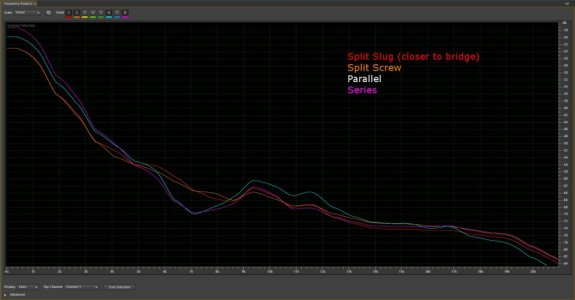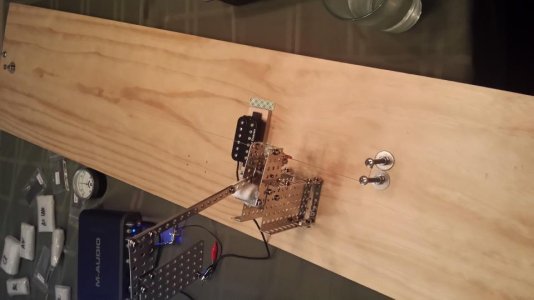eclecticsynergy
Well-known member
Okay, I have dozens of questions. But the ones at the top of my list right now fall into four areas.
1) Relative strength of the various alnico grades. First of all, I'm assuming that magnet strength correlates pretty directly with pickup output, that in a given pickup swapping to a more robust mag should increase the output a bit and vice versa. This is a safe assumption, right?
So, the prevailing wisdom seems to be rating them weakest to strongest: A3-A2-A4-A5-(A6)-A8. Yet some seem to feel A3 actually is as strong or stronger than A2- could that just be perception based on the fact that it's generally brighter overall? Also, some have said that A4 is actually the weakest of the bunch. I'm aware that there will be some variation from one manufacturer to another, possibly even from batch to batch. But in the aggregate (baaad pun, I know) the various grades must all shake out into a pretty coherent order. Can somebody with lots of experience please set this me straight on this once and for all?
2) A8s in lower winds. I have a couple of lower wind pickups that I'd love to beef up a little with an A5-to-A8 swap, but I'm seeing mixed opinions about it. At least one knowledgable voice have done it a lot and recommends it highly; others disagree. Where do you weigh in personally on this one? And among those who think it's not as great an idea as it sounds, what in your opinion is the downside? Do you think I'd be better off staying with A5 and trying roughcast/unpolished or unoriented?
3) Weaker mags with overwound coils. I have a couple of Epiphones with bridge pickups which, while adequate, to my ear sound less than ideal- slightly harsh and at the same time a bit lacking in definition. (Chinese, I think, in guitars dating from '010 and '013- DCRs read 14.0 and 13.98). Does anybody think an A4 or A3 mag might give them new life, a more articulate and dynamic voice? I don't need them to be particularly loud, since I have the PUs on these axes fairly low to better match the output of other instruments. There's room to raise 'em.
As an alternative to a mag swap, I've read somewhere that one can slightly degauss a humbucker without even taking it out of the guitar using a Neo magnet. Is this really a viable technique, and if so could mild degaussing warm them up a bit, maybe fill in the mid scoop somewhat?
[If they are a lost cause, I could be tempted to take 'em apart and try my hand at removing some winds. I'm not sure what kind of coil offset they've got and am a bit curious anyway, so it might be nice to have something pretty much disposable to experiment on. That way if I screw up it isn't a major loss.]
4) Grades/types of ceramics. I'm aware that some some overwound PUs like the DDs and SDs have extra thick ceramics, but I've also seen references to several different grades of ceramic mags, including C5 as well as the more common C8. Do these vary just in terms of strength, or do they indeed have different tonal natures- and if so, do they correspond at all to the characters of the various alnicos? Is there a C2, a C3? (And if there's a C4, is it highly explosive? Sorry, really couldn't resist that one...)
Thanks for your time. I appreciate any advice you have to offer on any or all of the above.
1) Relative strength of the various alnico grades. First of all, I'm assuming that magnet strength correlates pretty directly with pickup output, that in a given pickup swapping to a more robust mag should increase the output a bit and vice versa. This is a safe assumption, right?
So, the prevailing wisdom seems to be rating them weakest to strongest: A3-A2-A4-A5-(A6)-A8. Yet some seem to feel A3 actually is as strong or stronger than A2- could that just be perception based on the fact that it's generally brighter overall? Also, some have said that A4 is actually the weakest of the bunch. I'm aware that there will be some variation from one manufacturer to another, possibly even from batch to batch. But in the aggregate (baaad pun, I know) the various grades must all shake out into a pretty coherent order. Can somebody with lots of experience please set this me straight on this once and for all?
2) A8s in lower winds. I have a couple of lower wind pickups that I'd love to beef up a little with an A5-to-A8 swap, but I'm seeing mixed opinions about it. At least one knowledgable voice have done it a lot and recommends it highly; others disagree. Where do you weigh in personally on this one? And among those who think it's not as great an idea as it sounds, what in your opinion is the downside? Do you think I'd be better off staying with A5 and trying roughcast/unpolished or unoriented?
3) Weaker mags with overwound coils. I have a couple of Epiphones with bridge pickups which, while adequate, to my ear sound less than ideal- slightly harsh and at the same time a bit lacking in definition. (Chinese, I think, in guitars dating from '010 and '013- DCRs read 14.0 and 13.98). Does anybody think an A4 or A3 mag might give them new life, a more articulate and dynamic voice? I don't need them to be particularly loud, since I have the PUs on these axes fairly low to better match the output of other instruments. There's room to raise 'em.
As an alternative to a mag swap, I've read somewhere that one can slightly degauss a humbucker without even taking it out of the guitar using a Neo magnet. Is this really a viable technique, and if so could mild degaussing warm them up a bit, maybe fill in the mid scoop somewhat?
[If they are a lost cause, I could be tempted to take 'em apart and try my hand at removing some winds. I'm not sure what kind of coil offset they've got and am a bit curious anyway, so it might be nice to have something pretty much disposable to experiment on. That way if I screw up it isn't a major loss.]
4) Grades/types of ceramics. I'm aware that some some overwound PUs like the DDs and SDs have extra thick ceramics, but I've also seen references to several different grades of ceramic mags, including C5 as well as the more common C8. Do these vary just in terms of strength, or do they indeed have different tonal natures- and if so, do they correspond at all to the characters of the various alnicos? Is there a C2, a C3? (And if there's a C4, is it highly explosive? Sorry, really couldn't resist that one...)
Thanks for your time. I appreciate any advice you have to offer on any or all of the above.
Last edited:






